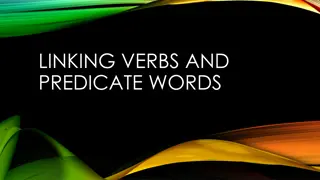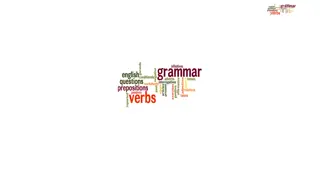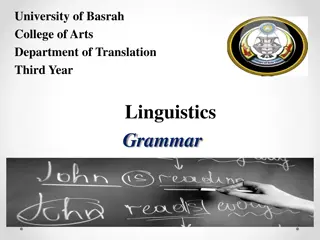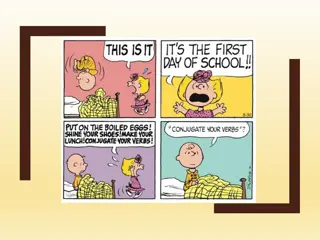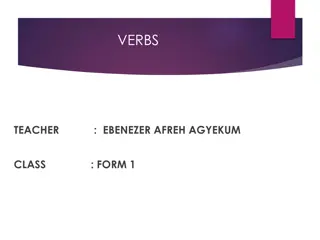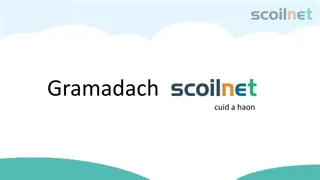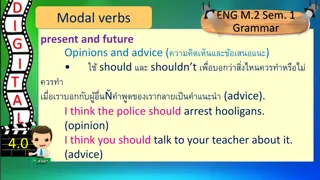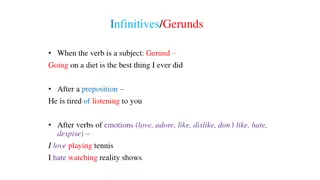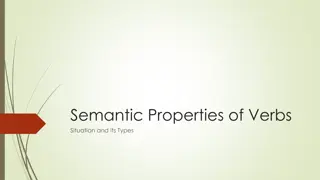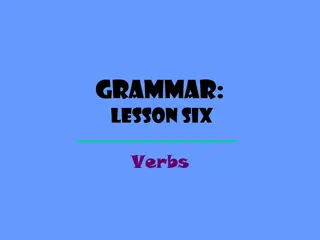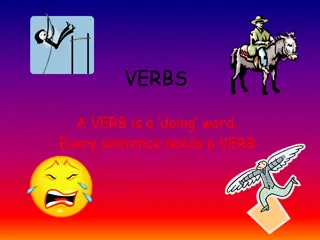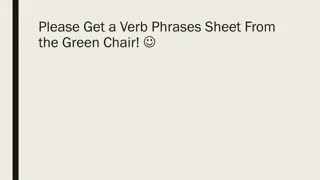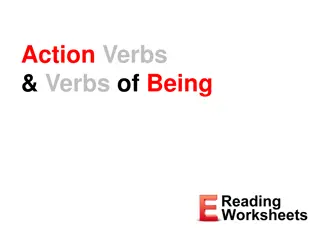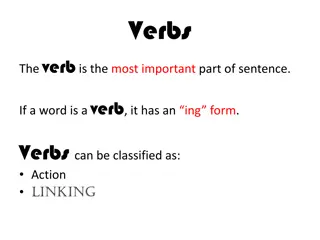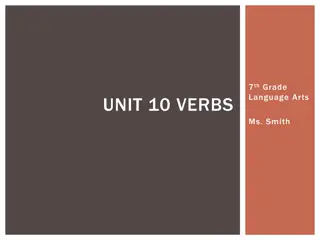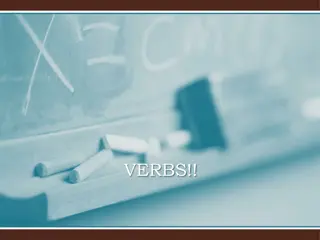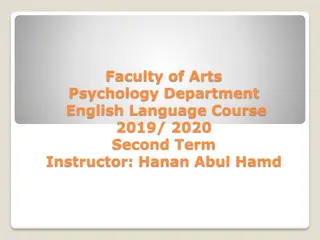Understanding Verbs: Types and Forms in English Grammar
Verbs in English grammar play a crucial role in expressing actions and states. They can be classified into various types such as action verbs, linking verbs, main verbs, auxiliary verbs, transitive verbs, intransitive verbs, and phrasal verbs. Verbs have six forms including base form, infinitive, past tense, past participle, present participle, and gerund. Understanding the forms and classifications of verbs is essential for mastering the English language.
Download Presentation

Please find below an Image/Link to download the presentation.
The content on the website is provided AS IS for your information and personal use only. It may not be sold, licensed, or shared on other websites without obtaining consent from the author. Download presentation by click this link. If you encounter any issues during the download, it is possible that the publisher has removed the file from their server.
E N D
Presentation Transcript
Todays Lesson Verbs
Verbs Verbs generally express an action or a state of being. There are several classifications for verbs- action verbs, linking verbs, main verbs, auxiliary verbs, transitive verbs, intransitive and phrasal verbs. Example: He goes to school regularly. She works hard so much. Here, goes, works are verbs.
There are six form of verbs. They are: Base form : I eat rice. Infinitive : Tell them not to play. Past tense : They worked hard yesterday. Past participle : He has done it. Present participle : I saw him playing with kids. Gerund : Swimming is the best exercise.
Base verb: The base verb is the form of a verb where it has no ending (-ing, -ed, -en) added to it. It is also called the Root Verb since it is the very root form of a verb. Examples: We go to school every day. You run a mile every morning. Do your work. Regular Verb The Verbs that follow the most usual conjugations are considered Regular Verbs. It is regular since it abides by most if not all of the regular grammar rules there are. Examples: Rahim plays cricket. Emi called out my name. She really walked all the way back?
Transitive Verb The Main Verb that takes a direct object sitting right after it would be a Transitive Verb. They usually construct the most straightforward of sentences. Examples: She went to the fair. We do not like being called out loud in crowds. I love visiting my village home. Intransitive Verb The main Verb that does not take a direct object specified right afterward and rather there is an indirect one mentioned somewhere along the line is called an Intransitive Verb. These verbs often make the corresponding sentences incomplete. Example: I laughed. John ran. A ghast of cold wind blew.
Finite Verbs Finite verbs are the actual verbs that are called the roots of sentences. It is a form of a verb that is performed by or refers to a subject and uses one of the twelve forms of tense and changes according to the number/person of the subject. Example: Alex went to school. (Subject Alex performed the action in the past. This information is evident only by the verb went .) Robert plays hockey. He is playing for Australia. He is one of the best players. (Here, the verb is directly refers to the subject itself.) Non-finite Verbs Non-finite Verbs are not actual verbs. They do not work as verbs in the sentence rather they work as nouns, adjectives, adverbs, etc. Non-finite verbs do not change according to the number/person of the subject because these verbs, also called verbals, do not have any direct relation to the subject. Sometimes they become the subject themselves. The forms of non-finite verbs are infinitive, gerund, and participle (participles become finite verbs when they take auxiliary verbs.) Example: Alex went abroad to play (Infinitives) Playing cricket is his only job. (Present participle) I have a broken bat. (Past participle) Walking is a good habit. (Gerund)
Linking Verb A linking verb adds details about the subject of a sentence. In its simplest form, it connects the subject and the complement that is, the words that follow the linking verb. It creates a link between them instead of showing action. Example: She appears ready for the game. (She is ready for the game.) The food seemed delicious. (The food was delicious.) You look happy. (You are happy.) Auxiliary Verbs Auxiliary verbs are also called helping verbs. An auxiliary verb extends the main verb by helping to show time, tense, and possibility. The auxiliary verbs are be verbs, have, and do. They are used in the continuous (progressive) and perfect tenses. Example: Alex is going to school. They are walking in the park. I have seen a movie. Do you drink tea? Don t waste your time. Please, do submit your assignments.
Modal Verbs A modal verb is a kind of auxiliary verb. It assists the main verb to indicate possibility, potentiality, ability, permission, expectation, and obligation. The modal verbs are can, could, must, may, might, ought to, shall, should, will, would. Example: I may want to talk to you again. They must play their best game to win. She should call him. I will go there. Reflexive Verb When the Subject and the Object are the same and the Verb reflects on the Subject, that is the Reflexive Verb. These Verbs are often used with Reflexive Pronouns like - myself, himself, herself, itself etc. Examples: He has done it himself. I'll watch it myself.
Learning Outcomes Definition of verb Classifications of verbs Definition of some kinds of verbs Identifying of verbs
Homework Write down definition of verb. Write down classifications of verbs. Write down definition of some kinds of verbs. Note down how to identify verbs.



